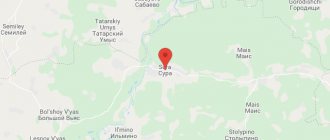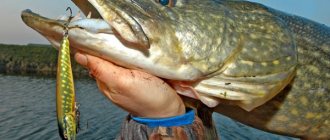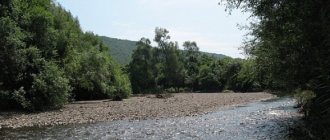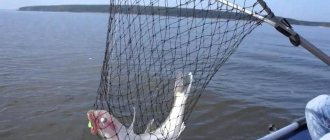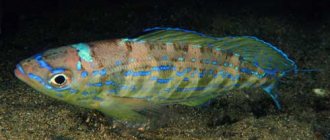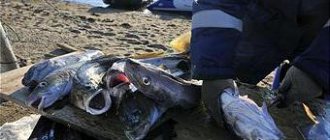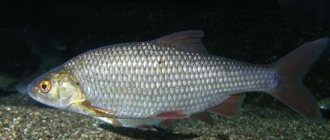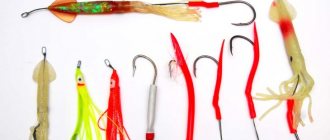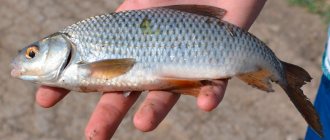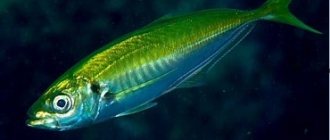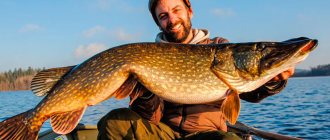Geography of the Azov Sea
Sea of Azov
The Sea of Azov is located in the south of the European part of Russia. It is a semi-enclosed internal reservoir, connected in its southern part with the Black Sea through the shallow Kerch Strait, and belongs to the Atlantic Ocean system.
The area of the Azov Sea is 39 thousand km2, its volume at the average long-term level is 290 km3, and its average depth is about 7 m. The greatest length of the sea from the Arabat Spit to the Don Delta is 360 km, and the maximum width from north to south is 180 km.
Two large rivers flow into the Sea of Azov - Don and Kuban, as well as about 20 small rivers, a significant part of which flows from the northern shore. The Don, flowing in from the northeast, forms a small multi-branch delta in its lower reaches, the area of which is 540 km2. The mouth of the Kuban, located in the southeastern part of the Sea of Azov, is a vast two-arm delta with an area of 4,300 km2. The average total flow of the Don and Kuban after its regulation is 28 km3/year.
The Sea of Azov is shallow. Its maximum depth is 15 m. The depth in the open part of the Azov Sea is 10-13 m. The greatest depth at the entrance to the Taganrog Bay is 9.6 m; from the entrance towards the top of the bay, the depths gradually decrease and at its top do not exceed 5 m.
And yet the Sea of Azov is not so small; it could easily accommodate two European states such as the Netherlands and Luxembourg. Its greatest length is 380 kilometers, and its greatest width is 200 kilometers. The total length of the sea coastline is 2686 kilometers.
Lures and bait
For both float and bottom fishing for rams, the same type of bait is used. The following are used as baits:
- steamed cereal grains;
- bloodworm;
- dung and earthworms;
- maggot;
- dough;
- semolina chatter;
- bakery products.
The best baits for catching rams in summer are maggots, and in winter, naturally, bloodworms and their sandwich with a blowfly larva.
Like all other carp fish, ram is very responsive to bait. For this, various grain mixtures are used with the inclusion of both large and dusty fractions, the main thing in which is invisibility on the bottom; sea roach is very wary of spots on the bottom that differ in color from the natural color.
Fishes in the Sea of Azov
The Sea of Azov, thanks to the prevailing favorable conditions, is one of the richest water basins in terms of the number of fish. It ranks first in terms of the number of catches per unit area. What kind of fish is currently found in the Sea of Azov? Now there are more than seventy species of fish in the basin.
All fish living in the sea are divided into three types.
1) Migratory fish are sturgeons; their spawning takes place in river floodplains. These are the most valuable fish species. These include:
- Stellate sturgeon
- Sturgeon
- Beluga
- Rybets
2) Semi-anadromous fish are fish that are most often found in the lower reaches of rivers. These include:
- Bream
- Taran
- Zander
3) Marine - fish that live permanently in the sea such as:
- Flounder
- Tulka
- Gobies
- Mullet
- Pilengas
Tackle
Of course, the first place for fishing from the shore is a telescopic fishing rod. It is better to choose a rod longer than 4.2 meters, and, if possible, slightly modify the whip. If it is tubular, then it is better to replace it with monolithic fiberglass; when biting, it better absorbs and protects the tackle from gusts.
The thinner and more transparent the line, the better. You should take different hooks, taking into account the color of the bait, reddish ones for bloodworms, light tinned ones for maggots. The optimal ones would be No. 18-22 for maggots, and for a worm from No. 12 to 6.
The ram's taste buds are located deeply, so it swallows the bait carefully and almost tenderly. Moreover, the colder the water and the fish moves slower, the more invisible the bite. Sometimes you accidentally pull, and a ram ends up on the hook, “tasting” the bait. It is preferable to choose a float that is lighter and thin.
Be sure to take a fish tank with you. You never know what little thing you come across, it’s better to let it go after you finish catching. Otherwise, the fish may unexpectedly leave.
In principle, you can take a landing net, it won’t be superfluous. But the fish are sluggish in the fall and can be fished without problems.
Taran is a type of roach, and a large one at that. You can catch it in the basins of the Azov and Black Seas.
Several decades ago there was quite a lot of it, and it was one of the commercial species that fed the south of Ukraine and Russia. Recently, its population has sharply declined, and it is found only by amateur fishermen.
Moreover, you can catch it only during a certain period. It spends most of its life at sea, but stays close to the shore and in places where rivers flow.
The fact is that the ram does not tolerate salt water, and therefore stays on the border with fresh water, where the salt in the water contains no more than 7 ppm. In this regard, it should be looked for in river mouths, canals, bays and estuaries.
Features of catching rams at different times of the year
Float
To catch rams, rods of the longest length are used, since the thicket of bait further from the shore guarantees both a larger catch and a more active fish bite. This will also ensure the presence of a coil on the form, which can be of medium power.
The main line is monofilament, approximately 0.20 mm. The braided line shows itself well; its size is sufficient 0.10...0.15 mm. The presence of leashes of 10...15 cm in length from ordinary fishing line of smaller diameter than the main one is required. Hooks for rams are suitable No. 3...No. 4 (our native classification).
If there is no wind, use a light float, since the depth for fishing for rams is usually around 1.5 m. At greater depths and the presence of wind, fishing for rams with a fishing rod is carried out with a heavier float. Load the floats so that only the antenna is slightly visible.
Donnaya
Such gear is always preferable to float gear, since it is easier to cast bait further from the shore. However, it is more difficult for them to catch caught prey, since it is very shy, behaves noisily in this case and can scare away the entire flock.
Of the many designs of donks for catching rams in March and other spring months, the most convenient is the one that has a retractable leash. Especially if it is mounted on a rod with a reel.
It can be used to drag the bait along the bottom, which usually stimulates the fish to bite. The best option is a feeder, the presence of a feeder with bait at which is also an incentive for ramming for an immediate bite.
A special requirement for all gear is that all components are resistant to salt water.
For shore fishing, ram float tackle is ideal, including telescopic rods 4.5 m long and with a monolithic fiberglass tip. The latter provides greater sensitivity of the gear and has increased shock absorption, which will protect you from unnecessary breaks.
It is better to use the thinnest fishing line for ramming in the fall that can withstand the intended prey. Hooks are used in different colors, which depends on the type of bait: for bloodworms it is better to use reddish ones, for maggots - tinned ones. Their optimal size is No. 18...No. 22 for maggots and No. 6...No. 12 for worms.
Floats in equipment for catching rams in the fall should be thin and light. The ram bites very gently in cold water, sometimes simply unnoticed by the fisherman. Therefore, on rough floats it is very difficult to notice.
And here's what you need to know: When to catch crayfish, when to catch crayfish, what they use to catch crayfish, methods of catching crayfish - Ogorodnik
A fisherman's equipment must include a landing net. Although the autumn ram is sluggish and is usually fished out without problems, it will not hurt if you come across a standing specimen.
Fishing on the Sea of Azov
Sea fishing is divided into several types.
- Firstly, this is fishing from a boat or, as it is also called, bottom sea fishing. This type of fishing is considered the most famous and widespread. And, naturally, it is popular with fishermen.
- The second type of sea fishing is shore fishing or surf fishing. This kind of fishing is also very common among sea fishermen.
- The third type of fishing at sea is catching larger species of fish with the interesting name trolling.
Fishing on the Azov Sea
Goby fishing on the Azov Sea
One of the most exciting and rewarding fishing in Azov is catching a bull, which is caught with the simplest bait. The optimal thickness of the fishing line is 0.6-0.7 mm, length 15 m. In addition, you will need two hooks No. 8 or 10, a sinker, the weight of which is selected depending on the diameter of the fishing line, usually a lead plate 3 by 2 cm twisted into a tube. The first hook is attached to the end of the fishing line, a load is hung 20 cm away from it, after 20 cm a leash of 20 cm begins, at the end of which another hook is attached.
As bait you can use the goby itself or other fresh or frozen fish, shrimp, or water worms. It is advisable to have several baits on hand, since the goby’s tastes change, and sometimes he can only bite on meat, and other times only on a worm.
It is better to go fishing early in the morning, before the water gets too hot. Closer to noon, due to the heat, the fish will go deeper and become passive.
Catching Azov ram
On summer days, the Azov ram approaches the coast. You can catch it on a bottom, however, the ram bites better on float rods, since this type of fish gets food in the middle layers of water, and not from the bottom.
In summer, the ram must be fed. To do this, you can throw a few different porridges, seed cakes, and bread crumbs at the fishing point. You only need to feed the fish when the bite subsides, otherwise you can overfeed the ram and it will not take the bait. The ram goes for both plant and animal bait. This can be bread, semolina, pearl barley, corn, wheat, sea worm and dung worm. When using bread crumb, honey is added to it for taste and viscosity. For this you will need 200 gr. Mix gray bread with one egg, a spoonful of fragrant sunflower oil and half a teaspoon of honey. You can use anise oil instead of sunflower oil; ram goes better with it. Anise oil can be dripped onto the rest of the bait, the bite will become more active. Ram fish are cautious, so it is advisable to select hooks that match the color of the bait.
Fishing for sawfish in the Sea of Azov
Another interesting fish that is found in Azov is the sawfish. The pelengas are caught in the first half of June, then it begins to refuse all the bait offered to it and only in August does the bite resume again.
To catch sawfish, you will need a powerful, long rod that can cast up to 100 meters. The length of the fishing line should be 300 meters, and its diameter 0.35 mm. The weight of the sinker is from 80 to 120 g.
Above the sinker, 2-3 leashes, 40–100 cm long, are attached to swivels. It must be remembered that the sawfish feeds in the water column, so the hooks must be lifted from the bottom. To do this, use foam balls, which are put on leashes near the hook or on the hook itself, but so that the sting remains open. The hook needs to float in the water and not lie on the bottom. Otherwise, you won’t be able to catch the sawfish. The best bait for pelengas is Nereis.
Winter fishing on the Sea of Azov
With the arrival of cold weather and after the Azov Sea covers the shores with ice, winter fishing in the Azov Sea begins. However, it is almost impossible to predict what fishing will be like on this body of water. Since the temperature here in winter is little predictable. There can be both positive temperatures and significant sub-zero temperatures, down to –25 C.
Winter fishing here is primarily for gobies of various species. In the cold season, they are caught for animal meat, pork, beef or chicken. As for the Azov ram, it is caught either with semolina or with bloodworms.
In the Sea of Azov you can catch anchovy and flounder in winter. As for flounder, it is not a schooling fish, and if one or two individuals are caught in one place, this does not mean that there is a whole school of flounder there. This fish is caught using floatless tackle. Fishing for flounder in the Sea of Azov in winter uses bait such as anchovy or sprat.
Safety measures in winter on the Sea of Azov
When winter fishing on ice, basic safety measures should be observed. You should go fishing only after sub-zero temperatures have lasted for several days. If the ice has a greenish tint, it means it has sufficient strength. If the wind blows towards the water, then it is better to abandon ice fishing, in this case the water may not completely freeze. This means that a piece of ice can break off and go into the open sea.
What and how to catch ram and pelengas?
From July to October, rams are caught in the sea. The best places for catching rams are reed thickets and estuaries. At this time of year, it is not whimsical; it can be caught using any bait from a boat, maggots, bloodworms, or any grains. Tackle float rod, feeder. In autumn, the ram goes into the river waters.
It is better to catch pelengas from a boat, as the fish is very cautious and moves away from the shore at the slightest danger. It swims in schools, and it is best to catch it in spring, autumn and late summer. Pelengas are caught only with the Nereis large worm, which is found exclusively in large bodies of water. It is a delicacy for all the fish that are found in the Sea of Azov.
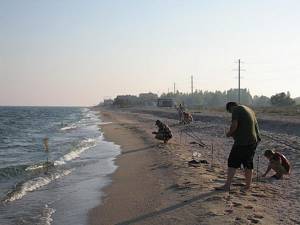
Bottom tackle with a strong rod, weight and several hooks. Pelengas can be caught from the shore in the same way as from a boat. The tackle is a float rod with a good rod and hooks depending on the size of the fish to be caught. The fishing line must be of sufficient length, since it will have to be cast over a distance of up to 100 meters. Many fishermen use braided line.
Fishing in the Sea of Azov from the shore includes several small nuances. First of all, you should not choose an area with a shallow and flat bottom, otherwise there will be no catch. You should also use rods that can be cast over a long distance. Well, you shouldn’t forget about silence, because it is the key to successful and productive fishing. Good fishing and good mood!
What kind of fish can you catch?
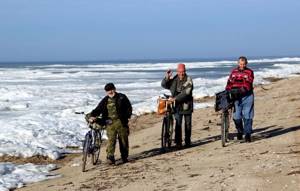
Many fishermen are interested in the question of what kind of fish is found in Azov in winter. The winter season is a great time for catching gobies, which are found in the waters of the Sea of Azov of all kinds (tsutsik, sandpiper, gorlac, bubyr, grasshopper, round goby and martovik). Surprisingly, some specimens caught in winter can reach a kilogram of live weight. In addition to goby, Azov anchovy, flounder and ram bite well in winter. And the most desired trophy among fishermen is considered to be pelengas.
How I did THIS
(Team move by Yaponamama-san)
On the very first day, as soon as I found myself in Azov, I rushed to go fishing and, naturally, took my spinning rod with me. However, the weather was “not suitable for flying”, at least for ultralight. I made a couple of casts (I broke the bait both times) and was almost completely disappointed in the Japanese version of rock fishing.
However, after a couple of fishing trips, day “X” finally arrived! The weather was sunny, warm and almost completely absent of wind. Therefore, despite the fact that the goby began to be caught even more intensively during the “classics”, I only took a spinning rod with me for fishing. True, I also had an “assistant” with me, and I grabbed an ordinary float for him.
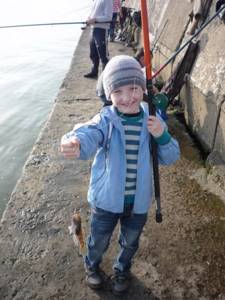
Assistant!
I set up a classic microjig rig:
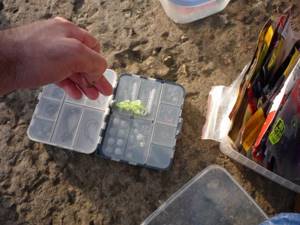
And here it is - a rockfisher's dream!
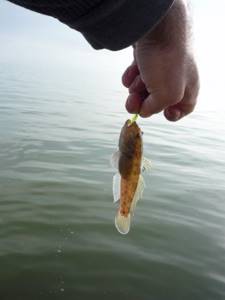
On 1.5″ Hogy Hog from Lucky John
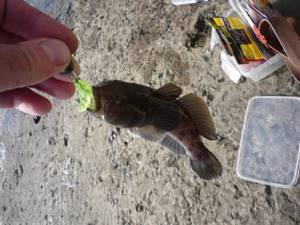
Again 1.5″ Hogy Hog from Lucky John
Having caught three gobies, I change the bait to test his preferences.
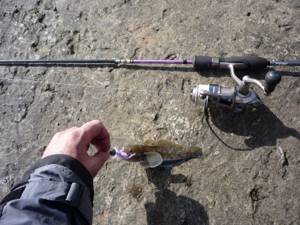
For a copy of the 2″ Ring Shrimp from Reins
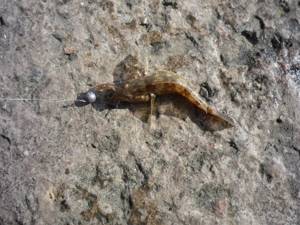
A copy of the 2″ Ring Shrimp from Reins in a different color worked again
You can't ignore the saddest thing! These are hooks and breaks... Of course, I used offsets, but it didn’t really help! If I managed to move the bait three times without getting caught, it was luck. Often the life of the bait ended on the first or second cast. And this despite the fact that I deliberately threw as far as possible - I felt that I was throwing stones and moving the bait along the sand for about 10 meters before the rubble began. Sometimes the goby caught while still on the sand, which saved it from a cliff. But most of the bites were still in the rocks.
In order to somehow solve the situation with the cliffs, I tied myself on a diverter leash. In my opinion, there weren’t much fewer hooks, but now it was possible to save at least somehow. For example, tear off only the sinker, or only the hook with bait.
But the diverter had one more result - the bite became much better! If there were also idle retrieves with the jig, then on the outlet the goby attacked the bait several times per retrieve. This happened, in my opinion, because the bait remained in the fish’s visibility zone longer and did not fall somewhere between the stones. With a jig, it seemed to me, it was necessary to hit the bull right in the forehead for a bite to occur. After all, the goby is an ambush predator and is unlikely to chase a galloping jig. But jumping out of his hole, grabbing a fish or crustacean hanging over the rocks and diving back is his usual way of hunting.
At the outlet we even started measuring catches with the assistant.
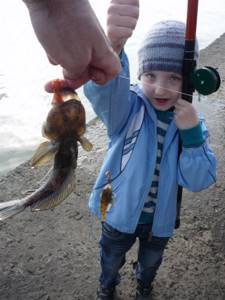
“Martovik” on LARVA 2″ from Fanatik
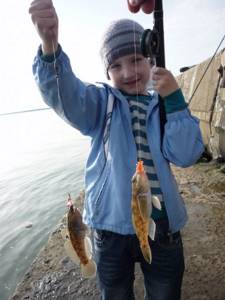
Large “caviar” on the tighter LARVA 2″
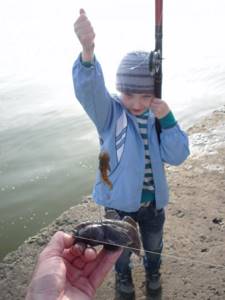
“Stoker” on AZURA Rocky 2″

Another “caviar” and again on AZURA Rocky 2″
Sometimes the Assistant took revenge on the size:
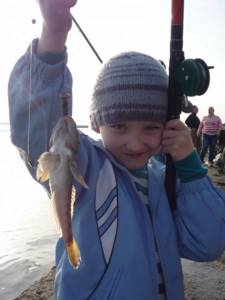
"Classics" in action! Everyone should be afraid!
In general, it was this fishing that restored my faith in the Japanese! Although I cut off a huge number of baits, the Assistant out-caught me in quantity and did not lose a single hook! True, he caught me only because I spent most of my fishing time tying lures.
I'm lucky. The calm (or almost calm) lasted another week! So I managed to “vicefish” in Japanese style more than once. True, I already tried to choose places with worse bite, but with fewer stones. A sandy beach would be ideal for not getting caught, but there were practically no fish here. That's why I chose the "rocky" beach.
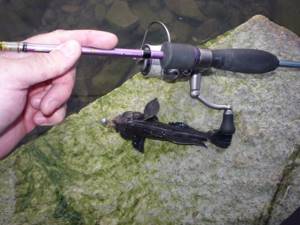
"Black beachgoer"!
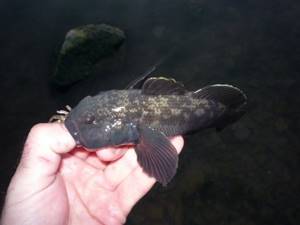
Evening goby
On one of the fishing trips, I even filmed almost an hour of video, a clip from which I already posted on Fish-Hook.ru: fish-hook.ru/polz…ideo/1453/
